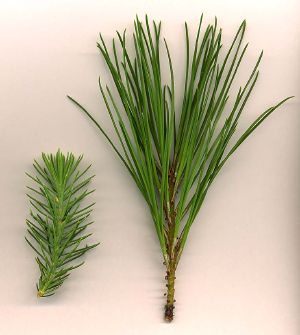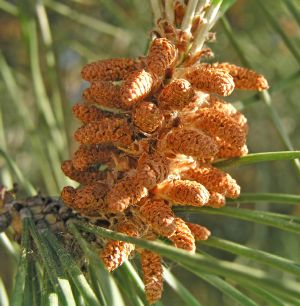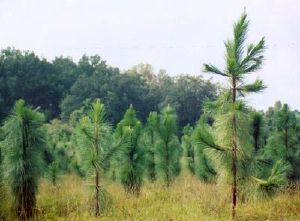Pine
| Pines | ||||||||||||
|---|---|---|---|---|---|---|---|---|---|---|---|---|
| 250px Maritime Pine (Pinus pinaster) | ||||||||||||
| Scientific classification | ||||||||||||
| ||||||||||||
| Species | ||||||||||||
|
About 115. |
Pines are coniferous trees of the genus Pinus, in the family Pinaceae. There are about 115 species of pine, although different authors accept anything from 105 to 125 species.
Distribution
Pines are native to most of the Northern Hemisphere. In North America, they range from the Arctic south to Nicaragua and Hispaniola, with the highest diversity in Mexico and California. In Eurasia, they range from Portugal and Scotland east to the Russian Far East, Japan, and the Philippines, and south to northernmost Africa, the Himalaya and Southeast Asia, with one species (Sumatran Pine) just crossing the Equator in Sumatra. Pines are also extensively planted in many parts of the Southern Hemisphere.
Morphology
Pines are evergreen and resinous. The bark of most pines is thick and scaly, but some species have thin, flaking bark. The branches are produced in regular "pseudowhorls", actually a very tight spiral but appearing like a ring of branches arising from the same point. Many pines are uninodal, producing just one such whorl of branches each year, from buds at the tip of the year's new shoot, but others are multinodal, producing two or more whorls of branches per year. The spiral growth of branches, needles and cone scales are arranged in Fibonacci number ratios. The new spring shoots are sometimes called "candles"; they are light-colored and point upward at first, then later darken and spread outward. These "candles" offer foresters a means to evaluate fertility of the soil and vigour of the trees.
Foliage
Pines have four types of leaves. Seedlings begin with
- a whorl of 4-20 seed leaves (cotyledons), followed immediately by
- juvenile leaves on young plants, 2-6 cm long, single, green or often blue-green, and arranged spirally on the shoot. These are replaced after six months to five years by
- scale leaves, similar to bud scales, small, brown and non-photosynthetic, and arranged like the juvenile leaves; and
- the adult leaves or needles, green (photosynthetic), bundled in clusters (fascicles) of (1-) 2-5 (-6) needles together, each fascicle produced from a small bud on a dwarf shoot in the axil of a scale leaf. These bud scales often remain on the fascicle as a basal sheath. The needles persist for 1.5-40 years, depending on species. If a shoot is damaged (e.g. eaten by an animal), the needle fascicles just below the damage will generate a bud which can then replace the lost growth.
Cones
Pines are mostly monoecious, having the male and female cones on the same tree, though a few species are sub-dioecious with individuals predominantly, but not wholly, single-sex. The male cones are small, typically 1-5 cm long, and only present for a short period (usually in spring, though autumn in a few pines), falling as soon as they have shed their pollen. The female cones take 1.5-3 years (depending on species) to mature after pollination, with actual fertilization delayed one year. At maturity the cones are 3-60 cm long. Each cone has numerous spirally arranged scales, with two seeds on each fertile scale; the scales at the base and tip of the cone are small and sterile, without seeds. The seeds are mostly small and winged, and are anemophilous (wind-dispersed), but some are larger and have only a vestigial wing, and are bird-dispersed (see below). At maturity, the cones usually open to release the seeds, but in some of the bird-dispersed species (e.g. Whitebark Pine), the seeds are only released by the bird breaking the cones open. In others, the fire climax pines (e.g. Monterey Pine, Pond Pine), the seeds are stored in closed ("serotinous") cones for many years until a forest fire kills the parent tree; the cones are also opened by the heat and the stored seeds are then released in huge numbers to re-populate the burnt ground.
Ecology
Pines grow well in acid soils, some also on calcareous soils; most require good soil drainage, preferring sandy soils, but a few, e.g. Lodgepole Pine, will tolerate poorly drained wet soils. A few are able to sprout after forest fires, e.g. Canary Island Pine. Some species of pines, e.g. Bishop Pine, need fire to regenerate and their populations slowly decline under fire suppression regimes. Several species are adapted to extreme conditions imposed by elevation and latitude; see e.g. Siberian Dwarf Pine, Mountain Pine, Whitebark Pine and the bristlecone pines. The pinyon pines and a number of others, notably Turkish Pine, are particularly well adapted to growth in hot, dry semi-desert climates.
The seeds are commonly eaten by birds and squirrels. Some birds, notably the Spotted Nutcracker, Clark's Nutcracker and Pinyon Jay, are of importance in distributing pine seeds to new areas where they can grow. Pine needles are sometimes eaten by some Lepidoptera species (see list of Lepidoptera which feed on Pines) and also the Symphytan species Pine Sawfly.
Classification of Pines

Pines are divided into three subgenera, based on cone, seed and leaf characters:
- Subgenus Strobus (white or soft pines). Cone scale without a sealing band. Umbo terminal. Seedwings adnate. One fibrovascular bundle per leaf.
- Subgenus Ducampopinus (pinyon, lacebark and bristlecone pines). Cone scale without a sealing band. Umbo dorsal. Seedwings articulate. One fibrovascular bundle per leaf.
- Subgenus Pinus (yellow or hard pines). Cone scale with a sealing band. Umbo dorsal. Seedwings articulate. Two fibrovascular bundles per leaf.
For more details, see Pinus classification (under construction).
List of pines by region
Old World
File:Pinecandle9872.jpg Young spring growth ("candles") on a Loblolly Pine |
File:Pine cone edit.jpg Monterey Pine cone on forest floor |
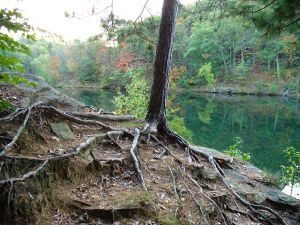 A red pine (Pinus resinosa) clearly displaying its roots |
File:Pinien La Brena2004.jpg Mature Pinus pinea (Stone Pine)- note umbrella-shaped canopy |
File:WhitebarkPine 7467t.jpg Whitebark Pine in the Sierra Nevada |
File:Sierra Madre.jpg Hartweg's Pine forest in Mexico |
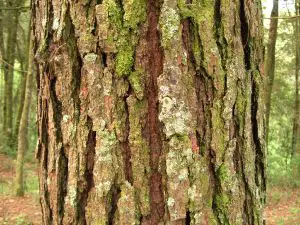 The bark of a pine in Tecpan, Guatemala. |
File:Pine needles volcanoes guatemala.jpg A pine, probably P. apulcensis, in Guatemala. |
- Europe and Mediterranean region (some extend into Asia)
- Pinus brutia - Turkish Pine
- Pinus canariensis - Canary Island Pine
- Pinus cembra - Swiss Pine
- Pinus halepensis - Aleppo Pine
- Pinus heldreichii - Bosnian Pine
- Pinus mugo - Mountain Pine
- Pinus nigra - European Black Pine or Austrian Pine
- Pinus peuce - Macedonian Pine
- Pinus pinaster - Maritime Pine
- Pinus pinea - Stone Pine
- Pinus sylvestris - Scots Pine
- Asia
- Pinus amamiana - Yakushima White Pine
- Pinus armandii - Chinese White Pine
- Pinus bhutanica - Bhutan White Pine
- Pinus bungeana - Lacebark Pine
- Pinus dalatensis - Vietnamese White Pine
- Pinus densata - Sikang Pine
- Pinus densiflora - Japanese Red Pine
- Pinus eremitana - North Vietnam White Pine
- Pinus fenzeliana - Hainan White Pine
- Pinus fragilissima - Wulu Pine
- Pinus gerardiana - Chilgoza Pine
- Pinus henryi - Henry's Pine
- Pinus hwangshanensis - Huangshan Pine
- Pinus kesiya - Khasi Pine
- Pinus koraiensis - Korean Pine
- Pinus krempfii - Krempf's Pine
- Pinus latteri - Tenasserim Pine
- Pinus luchuensis - Luchu Pine
- Pinus massoniana - Masson's Pine
- Pinus merkusii - Sumatran Pine
- Pinus morrisonicola - Taiwan White Pine
- Pinus orthophylla - Wuzhi Shan White Pine
- Pinus parviflora - Japanese White Pine
- Pinus pumila - Siberian Dwarf Pine
- Pinus roxburghii - Chir Pine
- Pinus sibirica - Siberian Pine
- Pinus squamata - Qiaojia Pine
- Pinus tabuliformis - Chinese Red Pine
- Pinus taiwanensis - Taiwan Red Pine
- Pinus thunbergii - Japanese Black Pine
- Pinus uyematsui - Uyematsu White Pine
- Pinus wallichiana - Blue Pine
- Pinus wangii (syn. P. kwangtungensis) - Guangdong White Pine
- Pinus yunnanensis - Yunnan Pine
New World
- Canada and USA, except for areas close to the Mexican border
- Pinus albicaulis - Whitebark Pine
- Pinus aristata - Rocky Mountains Bristlecone Pine
- Pinus attenuata - Knobcone Pine
- Pinus balfouriana - Foxtail Pine
- Pinus banksiana - Jack Pine
- Pinus clausa - Sand Pine
- Pinus contorta - Lodgepole Pine
- Pinus coulteri - Coulter Pine
- Pinus echinata - Shortleaf Pine
- Pinus edulis - Colorado Pinyon
- Pinus elliottii - Slash Pine
- Pinus flexilis - Limber Pine
- Pinus glabra - Spruce Pine
- Pinus jeffreyi - Jeffrey Pine
- Pinus lambertiana - Sugar Pine
- Pinus longaeva - Great Basin Bristlecone Pine
- Pinus monophylla - Single-leaf Pinyon
- Pinus monticola - Western White Pine
- Pinus muricata - Bishop Pine
- Pinus palustris - Longleaf Pine
- Pinus ponderosa (syn. P. washoensis) - Ponderosa Pine
- Pinus pungens - Table Mountain Pine
- Pinus radiata - Monterey Pine or Radiata Pine
- Pinus reflexa - Southwestern White Pine
- Pinus remota - Texas Pinyon or Papershell Pinyon
- Pinus resinosa - Red Pine
- Pinus rigida - Pitch Pine
- Pinus sabineana - Gray Pine, Foothill Pine or Digger Pine
- Pinus serotina - Pond Pine
- Pinus strobus - Eastern White Pine
- Pinus taeda - Loblolly Pine
- Pinus torreyana - Torrey Pine
- Pinus virginiana - Virginia Pine
- Southern Arizona and New Mexico, Mexico, Central America and Caribbean
- Pinus apulcensis - Apulco Pine
- Pinus arizonica - Arizona Pine
- Pinus ayacahuite - Mexican White Pine
- Pinus caribaea - Caribbean Pine
- Pinus cembroides - Mexican Pinyon
- Pinus chiapensis - Chiapas White Pine
- Pinus cooperi - Cooper's Pine
- Pinus cubensis - Cuban Pine
- Pinus culminicola - Potosi Pinyon
- Pinus devoniana (syn. P. michoacana) - Michoacan Pine
- Pinus durangensis - Durango Pine
- Pinus engelmannii - Apache Pine
- Pinus estevezii - Estevez's Pine
- Pinus gordoniana (syn. P. douglasiana) - Gordon's Pine
- Pinus greggii - Gregg's Pine
- Pinus hartwegii - Hartweg's Pine
- Pinus herrerae - Herrera's Pine
- Pinus hondurensis (syn. P. caribaea var. hondurensis) - Honduras Pine
- Pinus jaliscana - Jalisco Pine
- Pinus johannis - Johann's Pinyon
- Pinus lawsonii - Lawson's Pine
- Pinus leiophylla - Chihuahua Pine
- Pinus lumholtzii - Lumholtz's Pine
- Pinus maximartinezii - Big-cone Pinyon
- Pinus maximinoi (syn. P. tenuifolia) - Thinleaf Pine
- Pinus montezumae - Montezuma Pine
- Pinus nelsonii - Nelson's Pinyon
- Pinus occidentalis - Hispaniolan Pine
- Pinus oocarpa - Egg-cone Pine
- Pinus patula - Patula Pine
- Pinus orizabensis - Orizaba Pinyon
- Pinus pinceana - Weeping Pinyon
- Pinus praetermissa - McVaugh's Pine
- Pinus pringlei - Pringle's Pine
- Pinus pseudostrobus - Smooth-bark Mexican Pine
- Pinus quadrifolia - Parry Pinyon
- Pinus rzedowskii - Rzedowski's Pine
- Pinus strobiformis - Chihuahua White Pine
- Pinus tecunumanii - Tecun Uman Pine
- Pinus teocote - Teocote Pine
- Pinus tropicalis - Tropical Pine
Name origins
The modern English name pine derives from Latin Pinus by way of French pin; similar names are used in other Romance languages. In the past (pre-19th century) they were often known as fir, from Old Norse fyrre, by way of Middle English firre. The Old Norse name is still used for pines in some modern north European languages: in Danish, fyr, in Nowegian, furu, and Föhre in German (a name that has been replaced by Kiefer in everyday-speech, a word ultimately derived from Kien-Föhre, named after the Kienspan a small stick made of pine wood that was used as some kind of candle), but in modern English, "fir" is now restricted to Abies and Pseudotsuga. Other unrelated European names include Swedish tall, Dutch den, Finnish mänty, Russian sosna, Bulgarian and Serbo-Croat bor, and Greek pitys. In Chinese it is song, in Japanese matsu, and in Korean it is Sonamu. In Hebrew it is oren.
Uses
Pines are commercially among the most important of species used for timber in temperate and tropical regions of the world. Many are grown as a source of wood pulp for paper manufacture. This is because they are fast-growing softwoods that can be planted in relatively dense stands, and because their acidic decaying needles may inhibit the growth of other competing plants in the cropping areas. A typical example is Pinus radiata. The resin of some species is important as the source of turpentine. Some species have large seeds, called pine nuts, that are harvested and sold for cooking and baking. Some pines are used for Christmas trees, and pine cones are also widely used for Christmas decorations. Many pines are also very attractive ornamental trees planted in parks and large gardens. A large number of dwarf cultivars have been selected, suitable for planting in smaller gardens.
Pine plantations can be at risk of fire damage because pine resin is flammable to the point of a tree being explosive under some conditions.
Pine trees are also famous for their pleasant smell, but some people find the smell overbearing. A very small number of people are allergic to pine resin and its scent can trigger an asthma attack. What makes this particularly unusual is that it is also a treatment for asthma in some forms of alternative medicine.
Nutritional use
Pines are well-known survival food plants. The soft, moist, white inner bark, or cambium, found clinging to the dead, woody outer bark is edible and very high in vitamins A and C. It can be eaten in slices raw as a snack or dried and ground up into a powder for use as a thickener/flavoring in stews, soups, and other foods. The bunches of young green cones found at the ends of branches make a healthy hiking snack. A tea made by steeping young, green pine needles in boiling water (known as "strunt" in Sweden) is high in vitamins A and C.
ReferencesISBN links support NWE through referral fees
- Dallimore, W. & Jackson, A.B. revised by Harrison, S.G., 1967, A Handbook of Coniferae and Ginkgoaceae, New York : St. Martin's Press
- Farjon, A. 1984, 2nd edition 2005. Pines. E. J. Brill, Leiden. ISBN 90-04-13916-8
- Little, E. L., Jr., and Critchfield, W. B. 1969. Subdivisions of the Genus Pinus (Pines). US Department of Agriculture Misc. Publ. 1144 (Superintendent of Documents Number: A 1.38:1144).
- The Lovett Pinetum Charitable Foundation, 2006, Website [1]
- Miller, L., 2006, The Ancient Bristlecone Pine, Website [2]
- Mirov, N. T. 1967. The Genus Pinus. Ronald Press, New York (out of print).
- Richardson, D. M. (ed.). 1998. Ecology and Biogeography of Pinus. Cambridge University Press, Cambridge. 530 p. ISBN 0-521-55176-5
External links
- Classification of pines
- Arboretum de Villardebelle Images of cones of selected species
- Gymnosperm Database - Pinus
- Gymnosperm families - scroll down to the Pinaceae
| Links to other Pinaceae genera |
| Pinus | Picea | Cathaya | Larix | Pseudotsuga | Abies | Cedrus | Keteleeria | Pseudolarix | Nothotsuga | Tsuga |
Credits
New World Encyclopedia writers and editors rewrote and completed the Wikipedia article in accordance with New World Encyclopedia standards. This article abides by terms of the Creative Commons CC-by-sa 3.0 License (CC-by-sa), which may be used and disseminated with proper attribution. Credit is due under the terms of this license that can reference both the New World Encyclopedia contributors and the selfless volunteer contributors of the Wikimedia Foundation. To cite this article click here for a list of acceptable citing formats.The history of earlier contributions by wikipedians is accessible to researchers here:
The history of this article since it was imported to New World Encyclopedia:
Note: Some restrictions may apply to use of individual images which are separately licensed.
